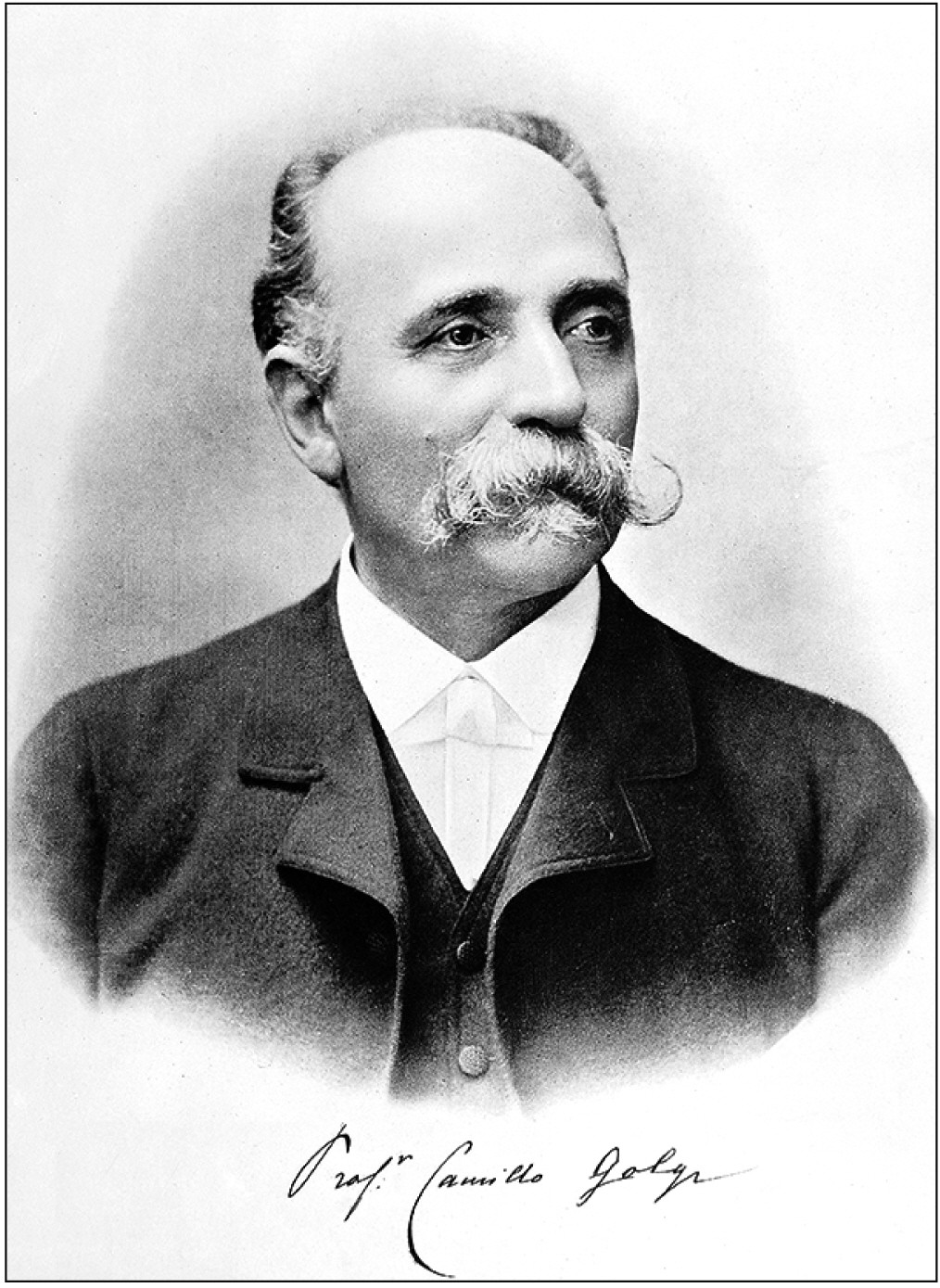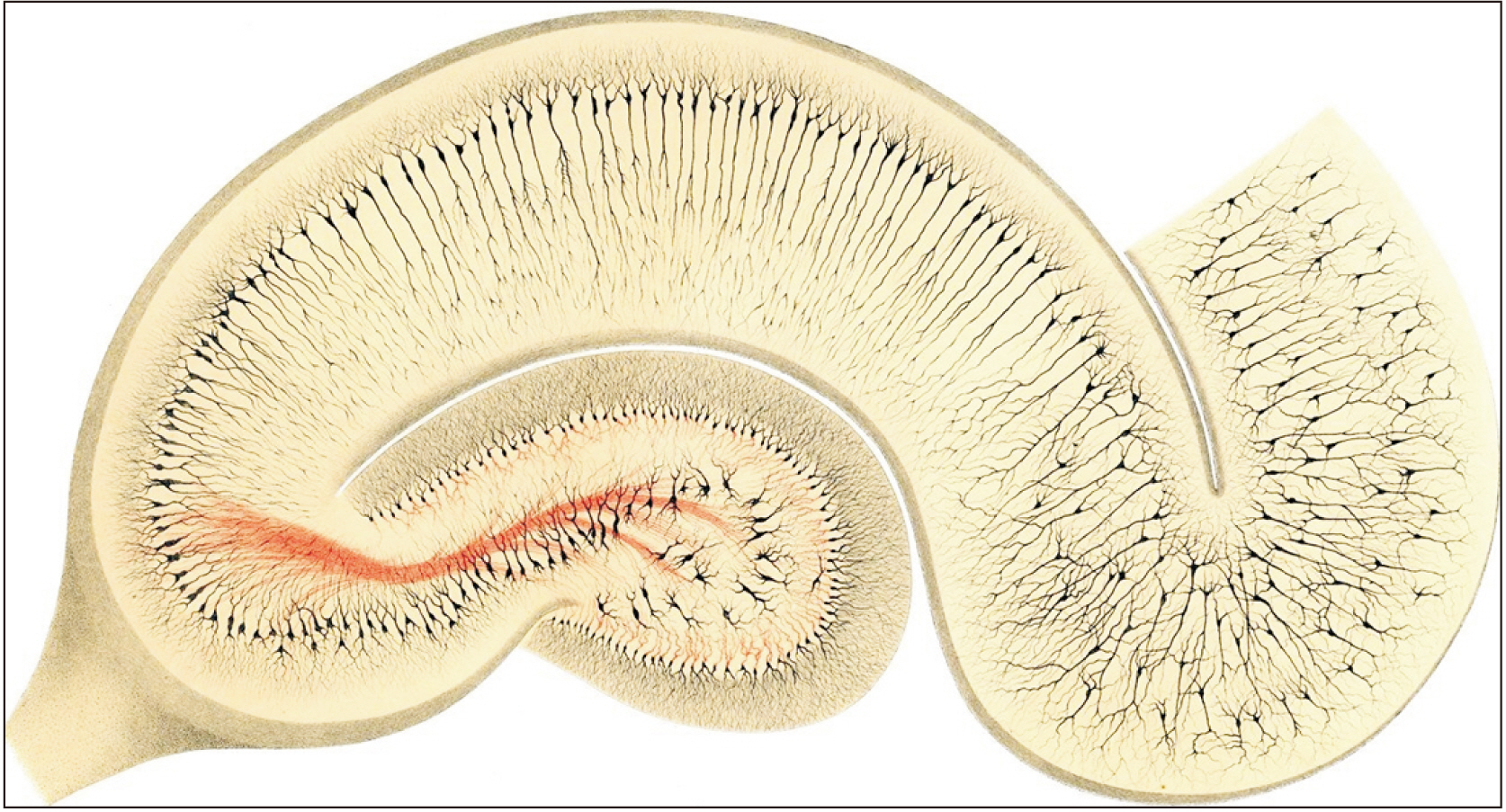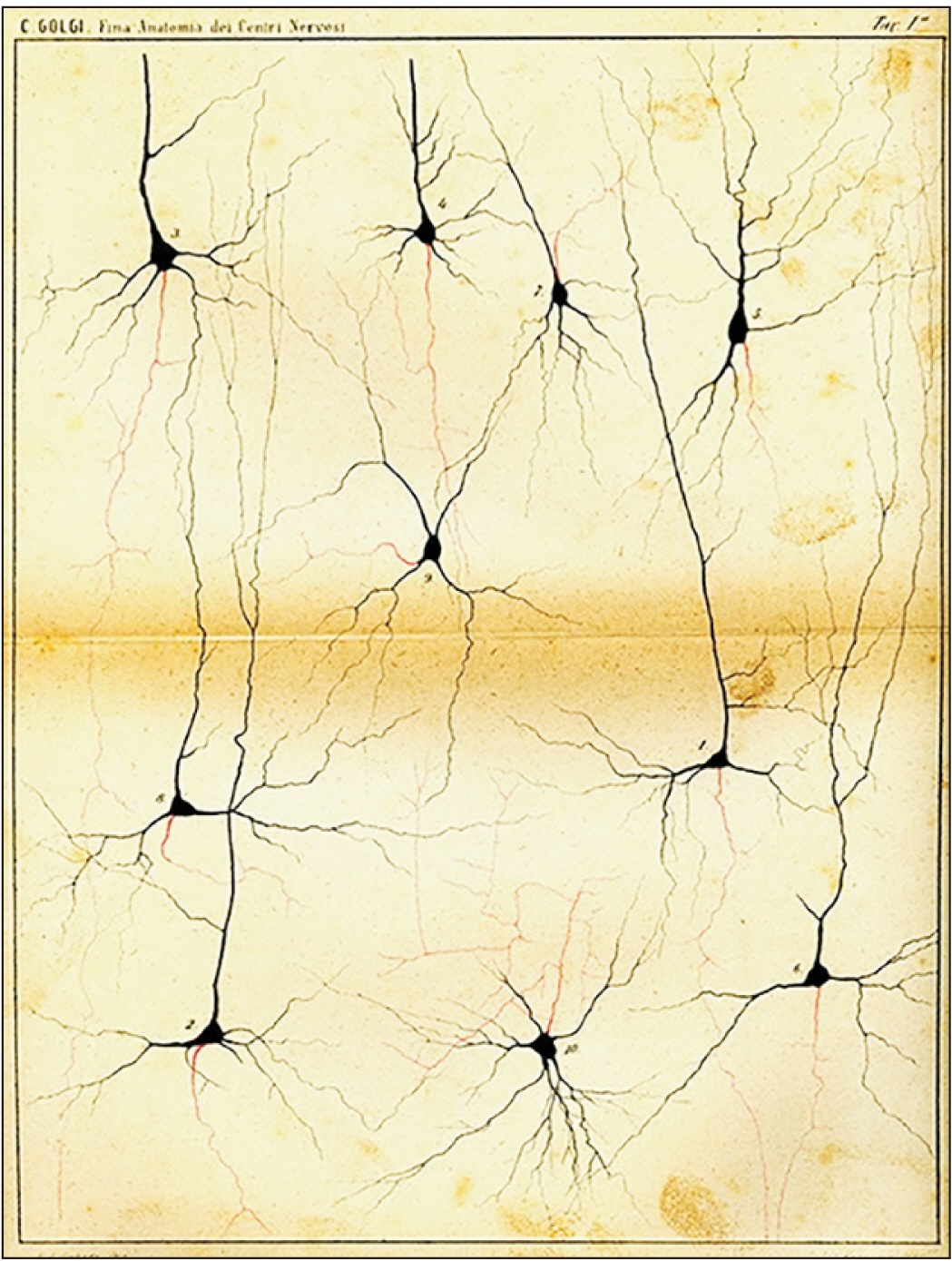Anat Cell Biol.
2020 Dec;53(4):385-392. 10.5115/acb.20.196.
Camillo Golgi (1843 –1926): scientist extraordinaire and pioneer figure of modern neurology
- Affiliations
-
- 1Department of Anatomy, All India Institute of Medical Sciences, Phulwarisharif, Patna, India
- KMID: 2509682
- DOI: http://doi.org/10.5115/acb.20.196
Abstract
- Camillo Golgi was an extraordinary scientist whose contributions in the domain of neuroanatomy proved to be critical for emergence of neuroscience as a sovereign scientific discipline. Golgi’s invention of the Black Reaction (La reazione nera) was a watershed event as it allowed remarkable visualization of the organizational pattern of elements of nervous system among complex puzzle of close knit interconnections. Till this time thin filamentary extensions of neural cells (axon and dendrites) could not be visualized with available staining techniques because of their slender and transparent nature. However invention of Black Reaction and its subsequent application demystified the basic architecture of brain tissue which was now visible to the scholars in all its complexity in microscopic studies. Golgi is also credited with the discovery of two types of sensory receptors in muscle tendons: Golgi tendon organ and Golgi-Mazzoni corpuscles. Golgi was the first to be successful in staining myelin component of axon, which he used to discover the myelin annular apparatus. He identified the complete life cycle of Plasmodium (malarial parasite) in human erythrocytes. His research on histological details of human kidney highlighted the existence of juxtaglomerular apparatus. Later on Spanish scientist Santiago Ramón y Cajal, based on the use of Golgi’s Staining (Black Reaction) documented the morphologic details of nervous system in a more refined manner, which eventually led to the emergence of Neuron Doctrine. In recognition of their exemplary contributions in neuroscience Golgi and Cajal were jointly awarded the Nobel Prize for Physiology or Medicine in 1906.
Keyword
Figure
Reference
-
References
1. Mazzarello P. 1999; Camillo Golgi's scientific biography. J Hist Neurosci. 8:121–31. DOI: 10.1076/jhin.8.2.121.1836. PMID: 11624293.
Article2. Friend DS, Murray MJ. 1965; Osmium impregnation of the Golgi apparatus. Am J Anat. 117:135–49. DOI: 10.1002/aja.1001170109. PMID: 14345830.
Article3. Ghosh SK, Narayan RK. 2020; Jun. 10. Anatomy of nervous system and emergence of neuroscience: a chronological journey across centuries. Morphologie. [Epub]. http://dx.doi.org/10.1016/j.morpho.2020.05.005. DOI: 10.1016/j.morpho.2020.05.005. PMID: 32534997.
Article4. Fodstad H. 2001; The neuron theory. Stereotact Funct Neurosurg. 77:20–4. DOI: 10.1159/000064596. PMID: 12378051.
Article5. Mazzarello P. [La struttura nascosta: la vita di Camillo Golgi]. Cisalpino;Bologna: Italian.6. Dröscher A. 1998; Camillo Golgi and the discovery of the Golgi apparatus. Histochem Cell Biol. 109:425–30. DOI: 10.1007/s004180050245. PMID: 9681625.
Article7. Calligaro A, Calligaro AL. 1999; The museum for the history of the university of Pavia and the birth of histology. J Hist Neurosci. 8:106–12. DOI: 10.1076/jhin.8.2.106.1842. PMID: 11624291.
Article8. Pannese E. 1996; The black reaction. Brain Res Bull. 41:343–9. DOI: 10.1016/S0361-9230(96)00177-3. PMID: 8973838.
Article9. Bentivoglio M, Mazzarello P. 1998; The pathway to the cell and its organelles: one hundred years of the Golgi apparatus. Endeavour. 22:101–5. DOI: 10.1016/S0160-9327(98)01133-8.
Article10. Hierons R, Meyer A. 1967; The anatomy of the brain and nerves. Proc R Soc Med. 60:314. DOI: 10.1177/003591576706000365. PMID: 30514530.11. Mazzarello P, Calligaro AL, Calligaro A. 2001; Giulio Bizzozero: a pioneer of cell biology. Nat Rev Mol Cell Biol. 2:776–81. DOI: 10.1038/35096085. PMID: 11584305.
Article12. Mazzarello P, Garbarino C, Calligaro A. 2009; How Camillo Golgi became "the Golgi". FEBS Lett. 583:3732–7. DOI: 10.1016/j.febslet.2009.10.018. PMID: 19833130.
Article13. Langmoen IA, Apuzzo ML. 2007; The brain on itself: Nobel laureates and the history of fundamental nervous system function. Neurosurgery. 61:891–907. discussion 907–8. DOI: 10.1227/01.neu.0000303185.49555.a9. PMID: 18091266.14. Kruger L. 2007; The sensory neuron and the triumph of Camillo Golgi. Brain Res Rev. 55:406–10. DOI: 10.1016/j.brainresrev.2007.01.008. PMID: 17408565.
Article15. Pannese E. 2007; The contribution of Camillo Golgi to our understanding of the structure of the nervous system. Arch Ital Biol. 145:111–5. PMID: 17639783.16. De Carlos JA, Borrell J. 2007; A historical reflection of the contributions of Cajal and Golgi to the foundations of neuroscience. Brain Res Rev. 55:8–16. DOI: 10.1016/j.brainresrev.2007.03.010. PMID: 17490748.
Article17. Torres-Fernández O. 2006; [The Golgi silver impregnation method: commemorating the centennial of the Nobel Prize in medicine (1906) shared by Camillo Golgi and Santiago Ramón y Cajal]. Biomedica. 26:498–508. Spanish. DOI: 10.7705/biomedica.v26i4.315. PMID: 17315476.18. Cani V, Mazzarello P. 2015; Golgi and Ranvier: from the black reaction to a theory of referred pain. Funct Neurol. 30:73–7. PMID: 26214031. PMCID: PMC4520677.19. Ghosh SK. 2015; Evolution of illustrations in anatomy: a study from the classical period in Europe to modern times. Anat Sci Educ. 8:175–88. DOI: 10.1002/ase.1479. PMID: 25053471.
Article20. Guillery RW. 2005; Observations of synaptic structures: origins of the neuron doctrine and its current status. Philos Trans R Soc Lond B Biol Sci. 360:1281–307. DOI: 10.1098/rstb.2003.1459. PMID: 16147523. PMCID: PMC1569502.
Article21. Golgi C. 1873; [Sulla struttura della sostanza grigia dell cervello', Gazz]. Med Lombarda. 33:224–46. Italian.22. Golgi C. 1874; [Sulle alterazioni degli organi centrali nervosi in un caso di corea gesticolatoria associata ad alienazione mentale]. Riv Clin. 4:361–77. Italian.23. Golgi C. 1875. [Sulla fina struttura dei bulbi olfattori: ricerche]. S. Calderini;Reggio Emilia:24. Golgi C. 1878; Della terminazione dei nervi nei tendini e di Nuovo apparato nervosa terminale musculo-tendineo. Atti della settima reunione straordinaria della Societa Italiana di Scienze Naturali in Varese. Milano, Tipografia di Giuseppe Bernardoni. 272–275.25. Golgi C. 1880; [Sulla struttura delle fibre nervosa midollate periferiche e centrali]. Arch Sci Med (Torino). 4:221–46. Italian.26. Golgi C. 1880; [Sui nervi dei tendini dell'uomo e di altri vertebrati e di un nuovo organo nervoso terminale musculo-tendineo]. Mem R Acad Sci Torino. 32:359–85. Italian.27. Brabin BJ. 2014; Malaria's contribution to World War One- the unexpected adversary. Malar J. 13:497. DOI: 10.1186/1475-2875-13-497. PMID: 25515618. PMCID: PMC4301033.
Article28. Ushkalov AF, Vikhert AM. 1972; [Morphology of the renal juxtaglomerular apparatus]. Arkh Patol. 34:3–17. Russian. PMID: 4264808.29. Barajas L. 1979; Anatomy of the juxtaglomerular apparatus. Am J Physiol. 237:F333–43. DOI: 10.1152/ajprenal.1979.237.5.F333. PMID: 386808.
Article30. Cowdry EV. 1921; Conservatism in cytological nomenclature. Anat Rec. 22:239–50. DOI: 10.1002/ar.1090220402.
Article31. Covell WP, Scott GH. 1928; An experimental study of the relation between granules stainable with neutral red and the Golgi apparatus in nerve cells. Anat Rec. 38:377–99. DOI: 10.1002/ar.1090380306.32. Douglas SH. 1935; A note on the work of v. la valette St. George, the discoverer of the Golgi apparatus and mitochondria of modern cytology. J R Microsc Soc. 55:28–31. DOI: 10.1111/j.1365-2818.1935.tb01186.x.
Article33. Golgi C. 1909; [Di una minuta particolarità di struttura dell'epitelio della mucosa gastrica ed intestinale di alcuni vertebrati]. Boll Soc Med Chir Pavia. 24:1–22. Italian.34. Yuste R. 2015; From the neuron doctrine to neural networks. Nat Rev Neurosci. 16:487–97. DOI: 10.1038/nrn3962. PMID: 26152865.
Article35. Fodstad H, Kondziolka D, de Lotbinière A. 2000; The neuron doctrine, the mind, and the arctic. Neurosurgery. 47:1381–8. discussion 1388–9. DOI: 10.1093/neurosurgery/47.6.1381. PMID: 11126909.
Article36. Jones EG. 1999; Golgi, Cajal and the neuron doctrine. J Hist Neurosci. 8:170–8. DOI: 10.1076/jhin.8.2.170.1838. PMID: 11624298.
Article37. De Carlos JA, Pedraza M. 2014; Santiago Ramón y Cajal: the Cajal Institute and the Spanish Histological School. Anat Rec (Hoboken). 297:1785–802. DOI: 10.1002/ar.23019. PMID: 25125377.
Article38. Kruger L, Otis TS. 2007; Whither withered Golgi? A retrospective evaluation of reticularist and synaptic constructs. Brain Res Bull. 72:201–7. DOI: 10.1016/j.brainresbull.2006.11.016. PMID: 17452282.39. Katz-Sidlow RJ. 1998; The formulation of the neuron doctrine: the Island of Cajal. Arch Neurol. 55:237–40. DOI: 10.1001/archneur.55.2.237. PMID: 9482368.40. Grant G. 2007; How the 1906 Nobel Prize in Physiology or Medicine was shared between Golgi and Cajal. Brain Res Rev. 55:490–8. DOI: 10.1016/j.brainresrev.2006.11.004. PMID: 17306375.
Article41. Chu NS. 2006; [Centennial of the nobel prize for Golgi and Cajal-founding of modern neuroscience and irony of discovery]. Acta Neurol Taiwan. 15:217–22. Chinese. PMID: 16995603.42. López-Muñoz F, Boya J, Alamo C. 2006; Neuron theory, the cornerstone of neuroscience, on the centenary of the Nobel Prize award to Santiago Ramón y Cajal. Brain Res Bull. 70:391–405. DOI: 10.1016/j.brainresbull.2006.07.010. PMID: 17027775.
Article43. Tabassum R, Jeong NY, Chung HJ. 2019; Big data differential analysis of microglial cell responses in neurodegenerative diseases. Anat Cell Biol. 52:469–77. DOI: 10.5115/acb.19.048. PMID: 31949987. PMCID: PMC6952691.
Article
- Full Text Links
- Actions
-
Cited
- CITED
-
- Close
- Share
- Similar articles
-
- Erratum to “Hugh A. Rose (盧厚德, 1926–2011), A Missionary Pioneer and the Cornerstone of Ophthalmology at Wonju Union Christian Hospital” by Lim SH, et al. (Yonsei Med J 2023 Mar;64(3):153-156)
- Aristotelian Philosophy in Its Bearing on Anatomical Thought
- Anatomical Achievement and Thought of Leonardo da Vinci
- ERRATUM: Corrected Figure Legend: Stroke Genetics: A Review and Update
- Inje Paik, a pioneer and visionary leader of modern medicine in Korea who practiced Noblesse Oblige






